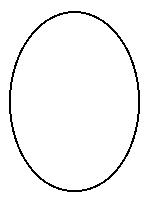 TRIZ
Textbooks: CID Course for Children, 2-2G01 TRIZ
Textbooks: CID Course for Children, 2-2G01 |
  
|
| Introductory
Lesson
Methods
of Solving Problems
Topic 1.
“We wouldn’t be happy if misery didn’t help us”
(Contradictions) |
Fantasy
City:
Course of Creative Imagination
Development (CID),
2nd Grade, 2nd Semester,
Methodical Guide-Book |
Natalia
V. Rubina, 1999 [published
in Russian]
English
translation by Irina Dolina,
May 4, 2001
Technical
Editing by Toru Nakagawa, Sept.
3, 2001 |
Posted
in this "TRIZ Home Page in Japan" in English on Sept. 11, 2001 under the
permission of the Author.
(C) N.V. Rubina,
I. Dolina, and T. Nakagawa 2001 |
Workbook
1. Warming-up
“Card index to the
CID lessons for the second grade, part 2”
3. Introduction to the lesson
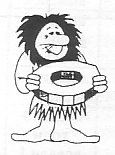
“The history of mankind
started with an invention. First stone instruments of labor were
devised and first man, homo sapiens, a man of reason appeared on Earth…
It’s difficult to enumerate how many inventions have been made since then.
Everything that surrounds us had to be invented. For example, we
don’t know who invented a sail; this wonderful invention has been living
for thousands years. And it will go on living: there are projects
of space ships with sun sails, absorbing the light pressure. Can
you imagine what an inventor felt when he was setting a sail for the fist
time? Probably, it was a sunny and windy day. A rush of wind
filled the roughly made mat and a sail, a raft left the shore. The
first in the history of mankind mast creaked, bending. Patches of
sunlight were dancing on the waves, but the man didn’t notice them.
His heart was beating madly: he was not sure where he would manage to reach
the shore again. He was scared to look back, but all the same – there
was a shocking, crazy, great moment of victory! The wind was obeying
the man for the first time, the raft was racing forward, splitting the
wave noisily …” (“And Suddenly the Inventor Appeared”, G. Altov,
Moscow, ”Detskaya Literatura”, 1984, p.126.)
4. Main topic
So, inventions surround
us everywhere. Let’s go along the streets of Fantasy City and look
around through the eyes of an inventor.
At the first
lesson on topic “Methods of solving problems” it is very important to use
knowledge and experience, that the children have acquired at the CID lessons.
I’ll remind you of the fact that while practicing the methods of making
images, we paid attention to the positive and negative consequences of
the changes in systems. “Technical systems, like living bodies, consist
of interconnected parts. If “for no reason” we enlarge one part of
the system, this will have a negative impact on its other parts.
That is why the inventive problems always contain two requirements: it
is necessary to improve some part (some property) of a system and at the
same time not to deteriorate its other parts (other properties) or all
the system as a whole. To make an invention means to overcome a technical
contradiction.” (G. Altov: “And Suddenly the Inventor Appeared”, Moscow,
“Detskaya Literatura”, 1989, p. 15.)
The properties of
the systems manifest themselves in the interaction with other systems.
In any interaction there are pluses and minuses. Plus means that the property
of a system meets the requirements of a super-system; minus means that
the same property contradicts the requirements of another super-system.
To solve a problem means to eliminate minus, preserving plus. (Fulfilling
these tasks, in which it is necessary to find systems that are big and
small, slow and fast at the same time, we have already tried to combine
opposite properties. In the problem about “a big hospital in a small
town” the hospital itself is big, but the separate parts are small.
The vacation can be slow in winter and fast – in summer). Our task
is to learn how to reveal pluses and minuses in a system, where the problem
emerged. In other words, to learn to reveal contradictions.
We are familiar already with some methods of solving contradictions: to
assemble – to disassemble, to do upside down, to divide in time. The talk
about the methods and rules of solving contradictions is ahead.
“The problem and the answer” are two banks
of the river. An attempt to guess the answer at once is like an attempt
to jump from one bank to the other. The technical contradictions
and the methods form a bridge. The theory of solving inventive problems
is , actually, a science about building unseen bridges, over which the
thought moves towards the new ideas.
However, the contradictions
and methods seem more correctly to be compared with the bridge piers.
To jump from a pier to a pier is not easy: one needs a guess-work to turn
from the problem to the contradiction and from the contradiction to the
method. Besides the piers the beams, connecting the piers, are needed
– then we’ll have a good bridge, over which we can quietly and confidently,
step by step come to from the problem to the answer.
We’ll talk about such a bridge later.
Meanwhile one thing is important: an inventor has to reveal and to overcome
the technical contradictions. This simple idea is the beginning of
the theory of solving inventive problems”.
(G. Altov “And Suddenly the Inventor Appeaed”. Moscow, “Detskaya
Literatura”, 1989, p.17.)


Problem 1. In summer
the branches of the trees hide the traffic light. The workers come,
dig out the post, replace it by another one, higher or curved. It
takes half a day. What can you suggest in this situation?
Let’s try to figure it
out. It is necessary that the traffic lights should be seen.
In summer the branches hide the traffic light. It is possible, of
course, to cut the branches, but they will grow again. Usually the
procedure is as follows: The traffic light pole is replaced. What
should be done to make the traffic lights be seen well, even if the pole
not to be replaced at all? Let’s articulate it another words.
If the traffic light
pole is replaced often, the lights will be seen well (+), but it takes
much time (–).
We need the pole, that
can change its size and its shape, and we don’t have to replace it often.
Have you imagined such a pole? What does it look like?
Write down your answer.
_______________________________________________________
It was proposed
to make the pole that can fold like an accordion: it can be easily increased
and decreased, curved and it doesn’t need to be replaced often.
And now, draw your
attention to the definition, that helped us to find the correct answer.
Let’s write down this definition, taking away everything that refers to
the concrete problem.
| Definition
1: A contradiction is a situation
where any change of the system or its parts can be considered good and
bad at the same time.
To formulate the contradiction the following form is used:
IF……………, it is good (+), but it is bad (–). |
This definition of the Contradiction
helps to see the essence of a problem, i.e., the most important thing in
the problem under consideration. To solve the problem means to solve the
contradiction. In other words, it is necessary to preserve (+) and
remove (–).

Problem 2. In a Latin American
country the government noticed that the merchants were concealing their
profits. To increase taxes, it seemed ineffective to reinforce punishments.
All the merchants were given the same forms of the bills to fill in when
they sold any product. But they began to sell goods, without writing
the bills (the customers didn’t need the copies of the bills and didn’t
ask for them). What should be done?
If………………………………………………………………….,
then (+)……………………………………………………………,
but (–)……………………………………………………………
If the merchants are
forced to write out the bills, the real profits will be revealed (+), but
it won’t be effective (–).
The customers can
help us by demanding the copies of the bills.
The administration
announced the lottery of the numbers on the bills. The customers
began to demand the copies of the bills from the merchants.

Problem 3. In the presence
of the police it is necessary to distribute the invitations to the secret
seminar. What should be done not to attract the attention of the
policemen?
If………………………………………………………………….,
then (+)……………………………………………………………,
but (–)……………………………………………………………
If the invitations
are distributed secretly only to the seminar participants, then (+) the
seminar will be attended only the people that are wanted, but (–)
the policemen might suspect something wrong.
The distribution of
the invitations shouldn’t arouse suspicion of the police.
The invitations were
given to everybody: the policemen got invitations to the concert, the secret
society members got invitations to the seminar.
7. Sum up
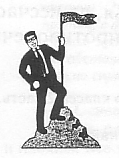
“The inventions, including
the process of creating, testing, and implementing, are always connected
with the fascinating adventures. The victory over a new technical
problem needs a flexible mind and courage not less than those that d’Artagnian
needed to fight the crafty designs of the Cardinal Rishilieau… However,
the inventory problems sometimes are stronger and more cunning than any
cardinals. If you want adventures, modern, clever, and useful to
people, invent! The fascinating adventures, that will last your whole
life, are waiting for you in the sphere of technical creativity.
But you have to prepare yourself for these adventures, beginning from childhood;
the earlier, the better, as in sports. So, don’t waste your time…
I wish you success!”
(“And Suddenly the
Inventor Appeared”, G. Altov, Moscow, “Detskaya Literatura”, 1984, p.126.
Homework:
Watch the city life, your life, and find contradictions, arising around
you. Write down your observations on the cards in the end of your
exercise book.
|
Methods
of Solving Problems
Topic 1.
“We Wouldn’t Be Happy If Misery Didn’t Help Us”
(Contradictions) |
Workbook
Lesson 1.
1. Warm up
“Card index to the CID lessons for the second
grade, part 2”.
2. Homework
What contradictions did you manage to find?

This task has an interesting psycho-correcting peculiarity.
The children often suggest contradictions that are the reflections of their
own worries. If a child articulates the contradiction, singles out
the problem, he will have a real possibility to solve it.
3. Introduction to the lesson

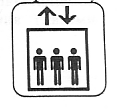
Problem 4 . The accident in an elevator. Four
people got stuck there. Three of them are upset, one is happy.
Who is he?
Let’s make a chart:
| |
+ |
– |
| A student with high grades |
|
|
| A student with low grades |
|
|
| A teacher |
|
|
| |
|
|
| |
|
|
| |
|
|
| |
|
|
| |
|
|
Direct the thoughts of the children
against the psychological inertia. This can be, for example, a kid,
who was playing “hide and seek”, or other games and who hid in this stuck
elevator. Ask them to think about other circumstances, when one needs
to hide safely for a while.
4. Main topic
So, the same incident may be considered to
be good and bad. All depends on a super-system, in which it happens.
This lesson is a continuation of
the talk about contradictions. Articulating of the contradictions
is one of the main and strongest instruments of TRIZ. The contradictions,
articulated correctly, lead to the solution of a problem. In order
to see and articulate the contradictions correctly, the systematic activities
are necessary. The best of such activities is solving school creative
problems first together with a teacher, then independently. Here
arises a rather commonplace problem, facing the adults in the course of
TRIZ education. In the beginning, in particular, while solving low-level
problems, it seems easier to sort out possible variants. Besides,
the well-known “national trait of a Russian” – the keenness of wit can
really helps to solve such problems. However, if you are enough patient
and insistent, you will notice that articulating the contradictions becomes
gradually the natural part of your students thinking.
5. Psycho-technical and developing games
Three piglets live in Fantasy City.
Nif-Nif is a cheerful piglet;
Naf-Naf is a grumbling piglet;
Nuf-Nuf is a clever piglet.

Problem 5. How to see three different piglets?

Three piglets like to play a game, called “Good
– Bad”. The rules of the game are rather simple. A situation
is offered, you have to explain what is bad and what is good there.

For this game the class is divided into
two groups. The first group acts on behalf of Nif-Nif and suggests
some solutions of the arising contradictions. The second group, acting
on behalf of Nuf-Nuf, reveals what is bad. From time to time
Nuf-Nuf shows up and offers some solutions of arising contradictions.
4. Main topic (continuation)
In order to learn how to devise an invention,
it is important to see (+) and (–) of any incident, and to remove (–),
preserving (+).

Activity 1. We can change systems with the help
of the methods of image making. Let’s look at these changes through
the inventor’s eyes:
- choose a system;
- apply any method of image making;
- what is good and what is bad in this change.
The system approach referring the
methods of making images was very precisely described in the work of I.
N. Murashkowska ”When I become a wizard”:
" “Once in Shanghai I saw a Chinese with
the ears so large that they served him as a pelerine. When the rain
started, the Chinese would cover himself with his ears and he was fine:
dry and warm. If he met his friends during the rain, he would cover
them with his ears. Then they would sit together and sing their sad
songs, until the rain stopped.” This is one of the stories, that
Peppy Long Stocking used to tell her friends. Let the kids give their
ideas how to use large ears.
It might turn out that they can not devise
any interesting solutions. Then, what? Why do they fail?
... let’s see what the system approach
to the work of such type can offer us.
We notice that the problem arises
because of the change of a system – the ears have become large.
We have to find an application for them, to define positive consequences
of this change. We know that the change of a system itself doesn’t
cause consequences. The consequences arise as a result of interaction
of the systems. It means that we need to see the possible super-systems,
the situations, in which this Chinese is involved. We will find out
with whom and with what he interacts there. Only after that
we will be able to determine the consequences.
Let’s single out typical situations for
any person: sleep, washing-up, morning exercises, eating, having a walk,
rest, sports, communication, trips, family events, encounters with friends
and so on. And untypical situation: dancing on a camel back, living
under the water, driving the clouds away, hiding the cities, etc. – anything
that comes to mind.
Let’s choose a situation – for example,
eating, - and add things that are also included in this super-system: a
table, a plate, rice, chop sticks, other eaters, smells, air, etc.
The ears are so large that they will hang
down on the table and it will be good because they can be used as plates.
Or if the rice falls down, it can be caught with the help of the ears and
put into the mouth – then the chopsticks are not needed. Some people
like kitchen smells, some people don’t; the ears can drive the smells away,
directing them to those who appreciate it. Uncovered food cools quicker,
the ears can keep it warm.”
I. N. Murashkowska: “When I become a wizard”,
Selection “Poznanie”, Riga, 1993.
Now we deal with the most interesting things.
Let’s try to use our knowledge about contradictions for solving the problems.
Take your time while sorting out variants.
Find a contradiction in the problem.
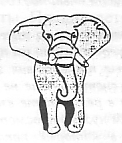
Problem 6. In the end of the last century some
interesting attraction was being demonstrated in the circuses around Europe:
an elephant that could count, add up, subtract, multiply and divide within
the limits of 100. There was a screen on the arena, with the numbers
from 1 to 100, distinctly written on it. The elephant took the pointer
with his trunk and pointed out the correct answer to the question, asked
by the audience. Guess the clue to this trick.
If………………………………………………………………….,
then (+)……………………………………………………………,
but (–)……………………………………………………………
If an elephant can really count, then (+)
the trick is solved, but (–) it is impossible
to train an elephant to count.
To specify this contradiction, let’s single
out a system, where the problem has appeared. It consists of the
elements: an elephant, a pointer, and a screen.
If an elephant is trained to hold the pointer
with his trunk, (+) he will be able to point at the screen, but (–)
the answers will be wrong.
Is it possible “to train” a pointer, but
not an elephant, to show correct answers on the screen? One of the
well-known properties of the iron pointers is to be attracted to a magnet.
We’ll use it to establish the necessary interaction between a pointer and
a magnet.
Indeed, the secret of the trick is in the
fact that the screen is equipped with an electromagnet. An operator
behind the curtains switches the cell on the screen, corresponding to the
correct answer. The trainer only has to train the elephant to keep
a pointer and to direct it towards the screen.
7. Sum up
Homework.
Problem 7. At the toys factory the doll “Carlson“
was being made. It is common knowledge that Carlson has to fly.
But at this point a contradiction has appeared. If a small screw
is made, Carlson will look like a real character and it will be very convenient
to play with him. But he won’t be able to fly. If a screw is
big, the doll will fly, but it will look like a windmill. Such a
doll can’t even stand on its legs. What can be done?
If………………………………………………………………….,
then (+)……………………………………………………………,
but (–)……………………………………………………………
If we make the fans of the screw
big, then (+) Carlson will fly, but (–) the
toy won’t be convenient to play with.
If we make the fans of the screw small,
then (+) Carlson will be comfortable to play with, but (–)
the toy won’t fly.
Thus, while flying, the fans must be big,
while resting they must be small.
We have already tried to solve such contradictions.
Big and small at the same time.
The fans of the screw should be made of
thin plates, that can be folded like the toy “tongue”. When
the plates are unfolded and become big, Carlson can fly.
Workbook
Lesson 2
1. Warming-up
“Card index to the CID lessons for the second grade, part 2”
2. Homework
Discussing the problem about Carlson.
3. Introduction to the lesson

Contradiction: In the
north it is getting dark very early. In order to light up the room,
many candles are needed. If there are many candles, (+) the room
is lighted up brightly, but (–) the candles
are expensive, they smoke, they burn out quickly.
4. Main topic

You will be surprised, but the best solution
is an ordinary electric lamp. We got used to it and even don’t notice,
how our life has changed with the appearance of the electric appliances.
Do you know what contradiction is concealed
in such a usual and convenient lamp? The lamp doesn’t burn itself,
it’s only the spiral that burns, it consists of some special staff.
This staff gives light when it is heated, but gradually it evaporates and,
unfortunately, is quickly broken. This is a contradiction:
if an electric lamp is heated much, it (+) gives bright light, but (–)
it is quickly broken. What is to be done?
Solution: day-light luminescent lamps,
in which a gas substance is burning instead of solid, metallic spiral.
The gas inside the flask can not evaporate and break, like a spiral.
All systems develop in the course
of arising and solving contradictions. There are many technical systems
around us, in which some contradictions were solved. A pencil consists
of the body and the slate. The main function of a pencil is to leave
traces on the paper. It performs its function thanks to the properties
of the slate – the ability to crumble and to stick to the paper.
Let’s imagine a slate without a body. The same properties would have
caused us a lot of trouble: the slate that is constantly being broken and
the hands that are always dirty. Now the next problem that has been
solved within this system. The drawing, the sketch, made by pencil,
sometimes need to be corrected or completely changed. In this case
one of the advantages of a pencil manifests itself: we can easily correct
inaccuracy, without altering the whole drawing. For that purpose
we need an eraser that we often leave behind or lose. How to preserve
the useful property of the system “pencil – eraser” - to make changes in
the drawing easily, and at the same time, to eliminate the ”bad” property
of the sub-system – eraser- to get lost or left behind? The solution
is well known to everybody: a pencil with an attached eraser. (Look
at this device that is applied to solve the contradictions – uniting the
systems for performing new functions. Later we’ll talk about this
method in detail at the lessons on topic “Perfection”). Is there
any other way of improving a pencil? What contradictions, existing
in this system today, will be removed in the pencils in the future?
The next activity is aimed at teaching
the kids how to find contradictions, already solved in the technical systems
around us. You may build together with us the chains of developing
common articles, that illustrate how the contradictions in these system
arise and are solved. And, may be, we’ll try to predict how these
systems will change in the future, which contradictions in them will be
solved.
Activity 1
As you see, the inventions are taking place
around us. Let’s look around through the eyes of an inventor.
Which contradictions have been solved in the following systems?
- a desk;
- a book;
- scissors;
- a pencil; |
- a blackboard;
- an eraser;
- a pencil-case;
- shoes. |
An ability to see and solve contradictions is
often important to expose a well-thought and planned fraud. Many
quite “peaceful” problems sometimes look like a small detective story.
7. Sum up
Homework.
Problem 8. One of the most fascinating performances
demonstrated by the lion’s tamers is when a lion opens his mouth wide and
a tamer places his head inside. This performance is very dangerous
because even the most obedient lion remains a beast of prey, no matter
how well he was tamed. How do the tamers manage to demonstrate this
trick?
If………………………………………………………………….,
then (+)……………………………………………………………,
but (–)……………………………………………………………
If to place in a lion’s mouth any object,
for example, a stick, which won’t let the jaws close, then (+) a tamer
will be protected safely, but (–) the trick
won’t be interesting to the audience.
Something that prevents the jaws from closing
should be concealed from the spectators. In the system, where this
problem arose, there are the following resources: the head of a tamer,
the mouth of a lion, namely, the tongue, the teeth, the lips, the cheeks.
Which of these resources can be used for solving the problems?
The secret of the trick is in the fact
that a tamer before putting his head inside a lion’ mouth, pulls the lion’s
lips on his teeth. When the lion tries to close his jaws, he scratches
his lips with his teeth.
Last updated
on Sept. 11, 2001. Access point: Editor:
nakagawa@utc.osaka-gu.ac.jp






